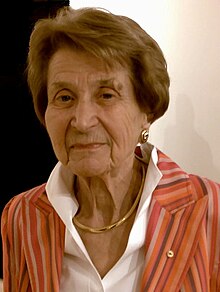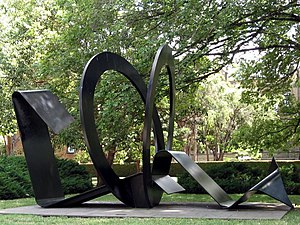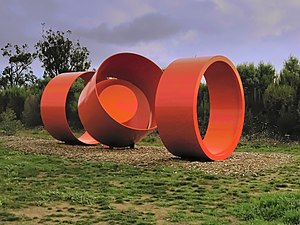Inge King
| Inge King | |
|---|---|

Inge King (2008)
|
|
| Born |
26 November 1915 Berlin, German Empire |
| Died | 23 April 2016 (aged 100) Melbourne, Australia |
| Nationality | German Australian |
| Education |
|
| Known for | Sculpture |
| Notable work | Forward Surge (1972–74), Melbourne Arts Centre. |
| Movement | Centre 5 |
| Awards |
|

Sun Ribbon
|
|
| Artist | Inge King |
|---|---|
| Year | 1980–82 |
| Medium | Sculpture |
| Subject | Painted steel |
| 37° 47′ 49.51″ S, 144° 57′ 43.4″ E | |
| Owner | University of Melbourne |

Forward Surge
|
|
| Artist | Inge King |
|---|---|
| Year | 1972 |
| Type | Sculpture |
| Medium | Painted steel |
| Location | Melbourne Arts Centre, St Kilda Road. |

Red Rings
|
|
| Artist | Inge King |
|---|---|
| Year | 2008 |
| Medium | Sculpture |
| Subject | Stainless steel |
| Location | junction of the EastLink Trail and the Dandenong Creek Trail |
| 37° 53′ 58.24″ S, 145° 12′ 50.25″ E | |
| Owner | ConnectEast |

Rings of Saturn
|
|
| Artist | Inge King |
|---|---|
| Year | 2006 |
| Medium | Sculpture |
| Subject | Stainless steel |
| Location | Heidelberg, Victoria |
| -37° 45.519', 145° 4.974' | |
| Owner | Heide Museum of Modern Art |
Ingeborg Viktoria "Inge" King AM (née Neufeld; 26 November 1915 – 23 April 2016) was a German-born Australian sculptor. She received many significant public commissions. Her work is held in public and private collections. Her best known work is Forward Surge (1974) at the Melbourne Arts Centre. She became a Member of the Order of Australia (AM) in January 1984.
Inge King (née Ingeborg Viktoria Neufeld) was born in Berlin on 26 November 1915, the youngest of four girls in a well-to-do Jewish family. Her early childhood was typical one for a child of her class and time in a European city. But after World War I, conditions in Germany became increasingly difficult. The period of the Weimar Republic (1918–1933), though a culturally stimulating time, was never stable. Conditions were made more difficult by the hyper-inflation of the early 1920s and the depression of 1929. During that time, things became increasingly difficult for the Neufeld family. By the time King's father died in 1930, when she was 14, the family had lost most of its money. Her older sisters supported her to stay at school until she finished, in 1932, which enabled her to get a good education. She would have liked to have gone on to university, possibly to study medicine, but, financially, that was out of the question.
King was 17 when Hitler came to power on 30 January 1933. Her older sisters, now married, decided to emigrate: one to Palestine, another to the US. By 1934, when she was 18, King was effectively on her own. She went to live with other young people in a small Zionist commune, where she worked in exchange for board and lodging. She said of this experience: “I owe them a lot ... This commune ... gave me or taught me some independence, which was invaluable”, and, most importantly, taught her “to survive without money”.
King was starting to think about being an artist, though this was really a second choice. But art was something she could do with minimal resources, so long as she could support herself. King was influenced both by mediaeval sculpture and by Expressionist sculpture, an important part of German avant-garde art, and particularly by the work of the wood-carver, Ernst Barlach (1870–1938). The Nazis considered such art to be decadent (Entartete Kunst) and later attempted to suppress it. King went to see the artist Käthe Kollwitz (1867–1945), whose work she admired. Kollwitz’ advice to King about a career in art was “Don’t do it if you can help it. It is so difficult”. Nevertheless, King did go on. She said: “I haven’t regretted it. I agree with her, it’s difficult.”
...
Wikipedia
